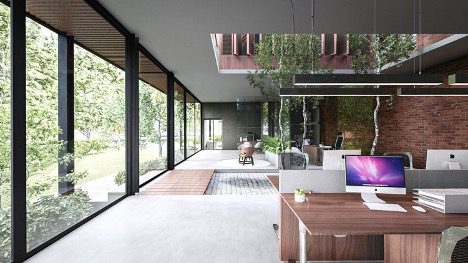Each month, we are examining the core principles of one of the ten concepts of the WELL Building Standard. The Standard identifies over 100 performance metrics, design strategies, and policies that are divided into ten sections or concepts: Air, Water, Nourishment, Light, Movement, Thermal Comfort, Sound, Materials, Mind, and Community. This month, we’re learning more about the Community Concept.

COMMUNITY CONCEPT
INTRODUCTION
The Community concept of the WELL Building Standard focuses on creating a sense of social connection and promoting healthy interactions among building occupants and the larger community. The WELL Building Standard is a performance-based system for measuring, certifying, and monitoring features of the built environment that impact human health and well-being.
Under the Community concept, buildings seeking WELL certification must demonstrate a commitment to fostering a sense of community through various strategies, such as promoting active transportation and connectivity to public transit, providing access to outdoor spaces and amenities, and supporting social equity and inclusion.
Every built space is home to a unique community of people with diverse characteristics who are linked by social ties, share common perspectives, and engage in joint action and experiences in shared settings or locations. The health of individuals in a community is impacted by various global, national, and local conditions, which are known as social determinants of health. These determinants can influence health disparities, which are differences in health status between population groups due to unequal distribution of power and resources based on factors such as gender, race, ethnicity, or socio-economic status.
To create a truly healthy and inclusive community, it is essential to address these social determinants of health and promote social diversity and inclusion through design, policy, and operations strategies. This includes providing access to affordable and comprehensive health services, promoting health-oriented policies and programs, and ensuring that buildings are accessible and safe for all individuals, regardless of their needs and abilities.
Design plays a critical role in addressing the physical determinants of health by incorporating universal design principles and complying with accessibility codes. Affordable housing units are also essential to improve overall health and provide a stable platform for the delivery of essential services to low-income populations.
GOALS
The WELL Community concept promotes strategies to build truly equitable, diverse, and healthy communities. The main goals of the community concept are to promote a sense of community, social connectedness, and well-being among the people who use a building or space. This concept recognizes the importance of social interaction, social support, and a sense of belonging to individual and collective well-being.
Here are some specific goals of the community concept:
1. Foster Social Interaction: by creating spaces that encourage people to come together and engage in activities that promote socialization.
2. Promote Social Support: by creating spaces where people can connect with others who share similar interests, goals, or experiences.
3. Enhance Wellbeing: by promoting positive social relationships, reducing social isolation and loneliness, and creating opportunities for personal growth and development.
4. Encourage Inclusivity: by creating spaces that are accessible and welcoming to people of all ages, abilities, and cultural backgrounds.
5. Promote Sustainability: by creating spaces that encourage environmentally responsible behavior and promote the use of renewable resources.
HEALTH IMPACTS OF SOCIAL ISOLATION AND LACK OF COMMUNITY

A lack of community can have a significant impact on both physical and mental health. Some of the health problems that have been linked to social isolation and a lack of community include:
- Depression and Anxiety: People who lack a sense of community may feel lonely, isolated, and disconnected, which can lead to negative mental health outcomes.
- Cardiovascular Disease: People who lack social support may experience chronic stress, which can have negative effects on cardiovascular health.
- Obesity: A lack of community can contribute to obesity by reducing opportunities for physical activity and increasing reliance on unhealthy food options. Social isolation has been linked to increased rates of sedentary behavior and unhealthy eating habits.
- Cognitive Decline: People who lack social interaction may experience cognitive decline at a faster rate than those who have a strong social support system.
- Substance Abuse: People who feel disconnected from their community may turn to substance abuse as a way to cope with their feelings of loneliness and isolation.
- Increased Inflammation: Chronic inflammation is a risk factor for many chronic diseases, including cancer, diabetes, and cardiovascular disease.
- Weakened Immune System: Social isolation has been linked to a weakened immune system, which can increase the risk of infections and illnesses. People who lack social support may be more susceptible to colds, flu, and other infectious diseases.
- Sleep Problems: Sleep problems, including insomnia and disrupted sleep patterns, can contribute to a range of health problems, including obesity, diabetes, and cardiovascular disease.
- Poor Self-Care: People who lack social support may be less likely to engage in self-care activities, such as regular exercise, healthy eating, and preventive health care. Poor self-care can contribute to a range of health problems, including chronic diseases and mental health disorders.
- Increased Mortality: People who lack social support may have a higher risk of premature death from a variety of causes, including cardiovascular disease, cancer, and accidents.
DESIGN INTERVENTIONS

When planning a building to support community interaction, architects and designers should consider several factors to create a space that fosters a sense of community. Here are some things they should keep in mind:
- User Needs: Design professionals should consider the needs and preferences of the people who will use the building. For example, they should think about the age range and cultural backgrounds of the users, as well as the activities they are likely to engage in.
- Space Planning: The layout of the building should be designed to encourage social interaction and community engagement. For example, common areas, such as lobbies, lounges, and community rooms, should be easily accessible and located in areas that are likely to attract users.
- Access to Nature: Access to natural light, outdoor spaces, and greenery can improve the overall well-being of users and encourage community interaction. Architects and designers should consider ways to incorporate nature into the building’s design, such as green roofs, courtyards, and balconies.
- Universal Design: Incorporating universal design principles into the building’s design can make the space more accessible and inclusive for people of all ages and abilities. This can promote social equity and create a sense of community among diverse groups of people.
- Flexibility: The building’s design should be flexible and adaptable to changing needs and activities. This can help ensure that the space remains relevant and useful to users over time.
At TSD we believe it is important for both professionals (architects, interior designers, and contractors) as well as building users (homeowners, business owners, school administration, maintenance personnel, etc.) to understand the problems as well as the potential solutions for creating and maintaining healthy interior spaces. By focusing on addressing health disparities and promoting social diversity and inclusion, we can create a healthier, happier, and more inclusive world for all.
If you want to know more about making your home or office a safer and healthier environment, reach out to us by email or DM us on Instagram. Also, if you missed any of our past blog posts summarizing the WELL Building Standard concepts, you can revisit them here: Air, Water, Nourishment, Light, Movement, Thermal Comfort, Sound, Materials, and Mind.

Taleah Smith Design is an interior design studio based in Vancouver, British Columbia. We specialize in interior design that promotes wellness and sustainability. We believe your living space should promote a greater sense of health and wellbeing, and we approach this goal from many difference angles. If you would like to discuss a project, you can reach out to us here.
We also provide resources and consulting for other interior designers looking to integrate wellness and sustainability into their design practices. If you would like to learn more, contact us here.
